

Forty days after Christmas, on February 2nd is the Christian celebration or 'feast' of the Presentation of Christ in the Temple, also known as the Purification of the Virgin Mary, or simply as Candlemas. It celebrates the presentation of Jesus in the temple at Jerusalem, and the ritual purification of his mother Mary. According to Jewish law (Leviticus 12), after the birth of a male child the mother was ritually unclean for 40 days after the birth. At that time, she was to bring an offering and present herself to the priest to be purified. The law specified that the offering was to be a lamb; or if the family could not afford that they were to bring two doves or pigeons. In his birth narrative, Luke records that when the time came for the purification, Mary and Joseph brought Jesus to the temple in Jerusalem to present him to the Lord, and they offered a sacrifice according to the law, "a pair of turtledoves or two young pigeons." The offering of a pair of birds implies that the couple was too poor to afford a lamb for an offering. While in the temple, an elderly devout man named Simeon, perceives that Jesus is the promised Messiah. In words which we have come to call the Song of Simeon or the Nunc dimittis (Latin for “Now let me depart”) Simeon declares that having seen the Messiah he can now depart this life in peace. Simeon foresees that Jesus will become a light to the Gentiles, but that he will also be a cause of division, sorrow, and judgment. At that moment, the 84-year-old prophet Anna began to praise God and to speak about the child to all who were looking for the redemption of Jerusalem.
Candlemas celebrates the many themes of these events, presentation, purification and light for the world. Candlemas is a turning point in the church year, it marks the point at which we take a last look back at Christmas and then turn our minds firmly towards the the cross and Easter. We have been working through the Sundays of Epiphany, now we leave them behind, and soon it will be Lent.
blank
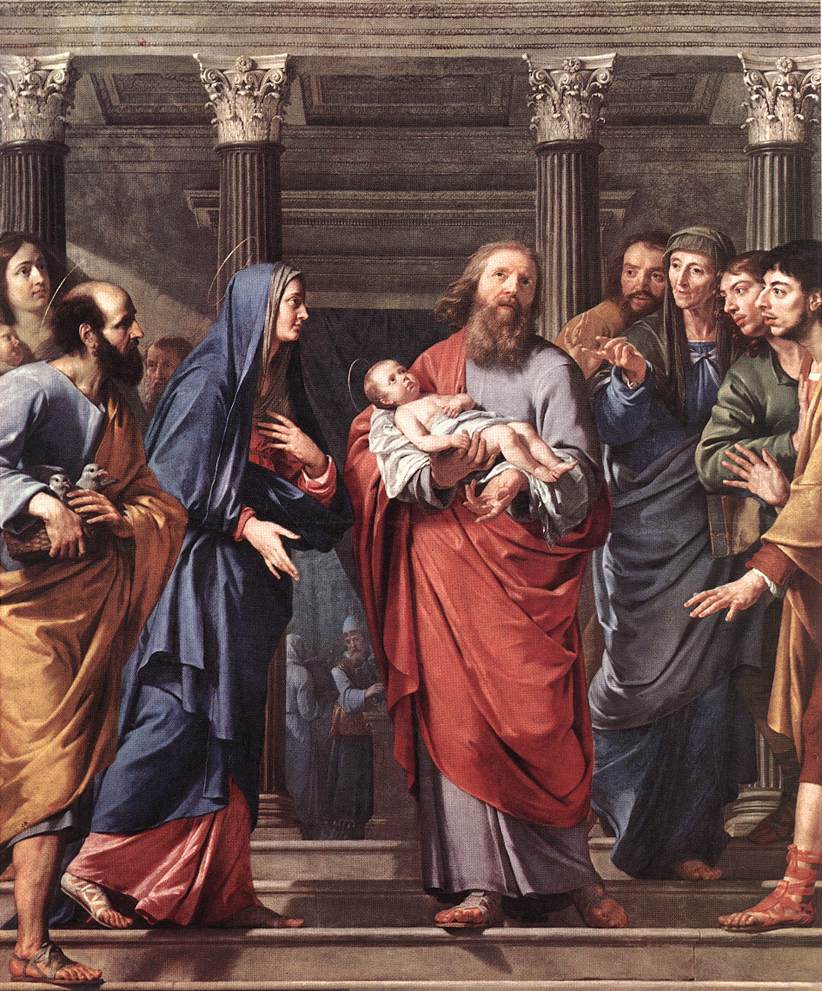 |
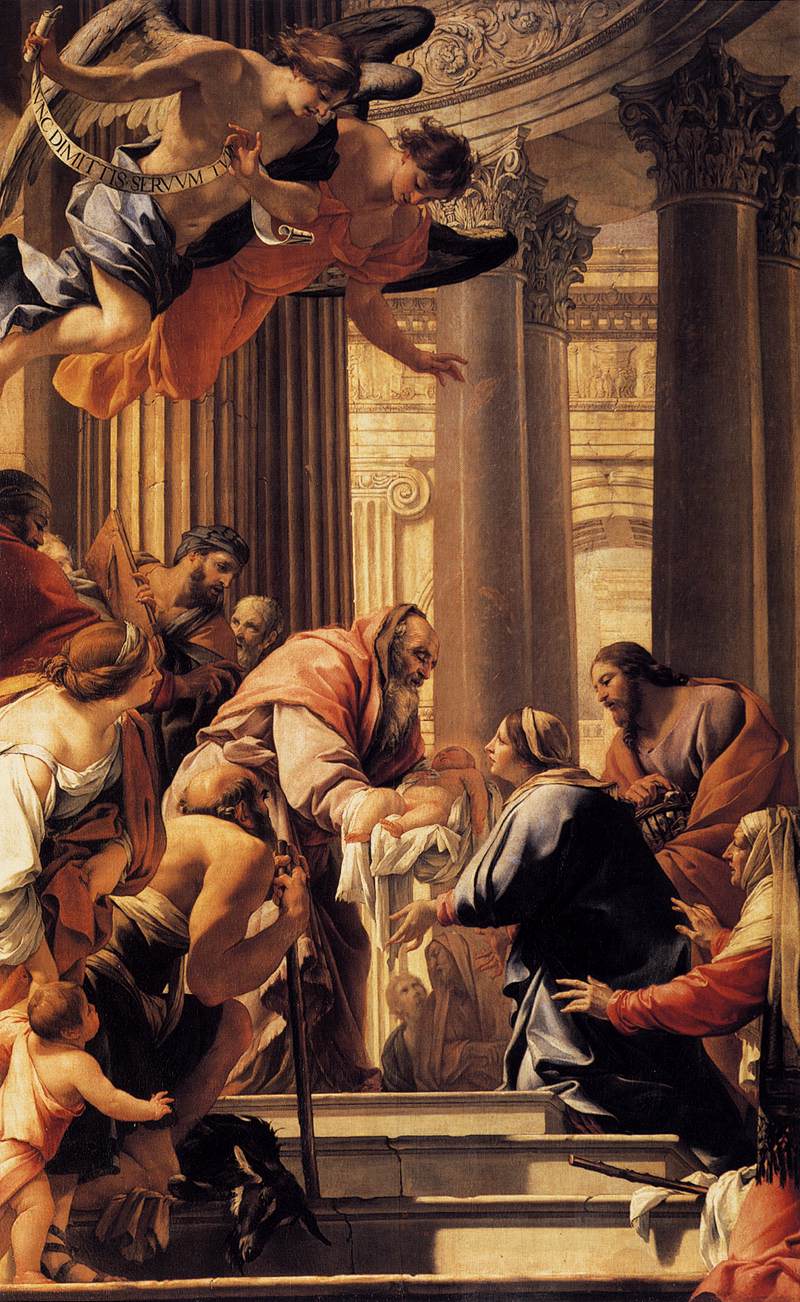 |
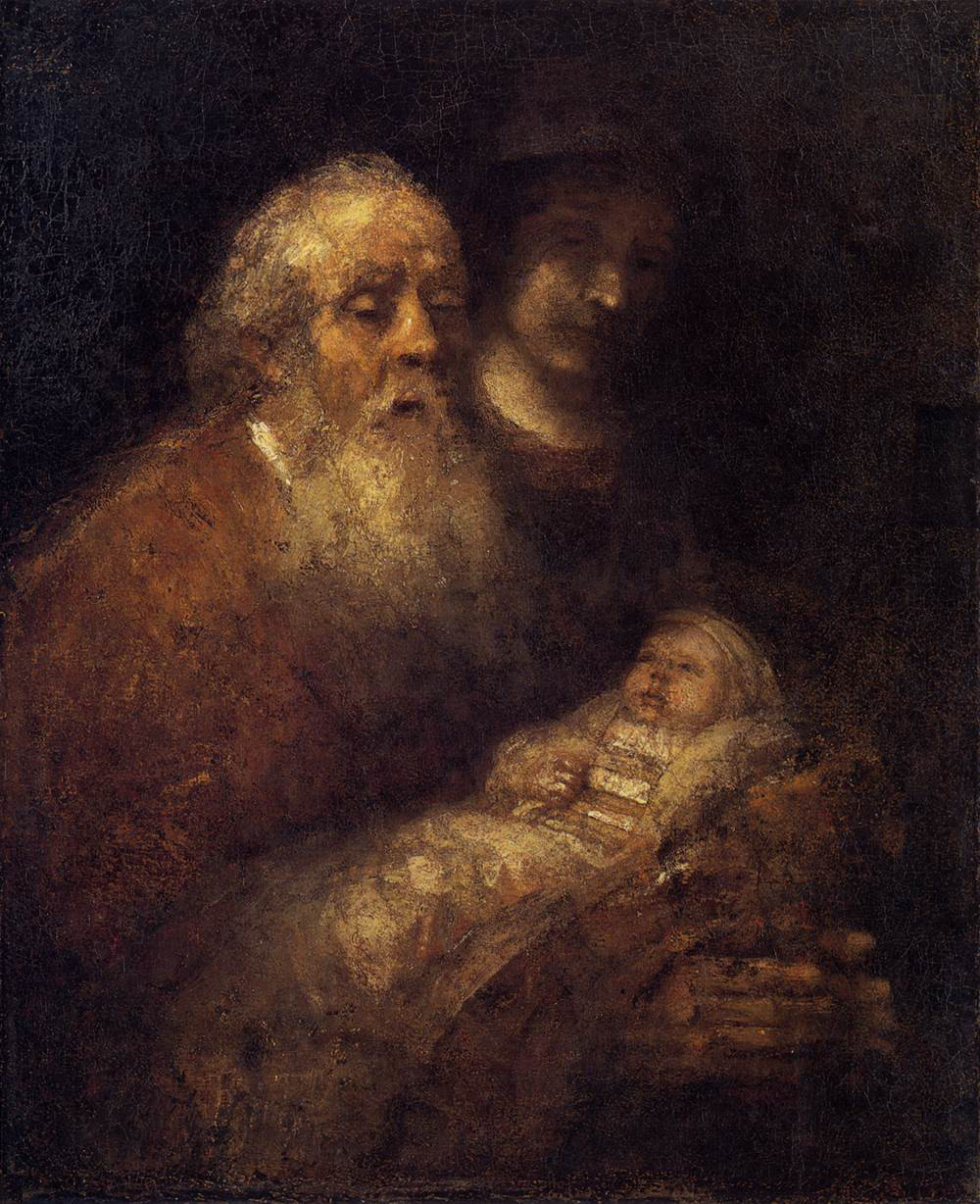 |
| Philippe de Champaigne, 1648 | Simon Vouet, 1640 | Rembrant van Rijn, 1669 |
|
Lord, the Roman hyacinths are blooming in bowls and Grant us thy peace. I have walked many years in this city, Before the time of cords and scourges and lamentation |
Grant us thy peace. Before the stations of the mountain of desolation, Grant me thy peace. (And a sword shall pierce thy heart, Thine also.) |
Light is a central symbol of the Presentation. Coming in the season after Epiphany, the feast celebrates Christ as the Light of the World. In the Epiphany, the magi or wise men recognized the significance of the newborn Jesus. Likewise, in the Presentation, Simeon and Anna are also enlightened as they recognize and proclaim Jesus as the awaited Messiah.
Light has always been a significant image of Christian spirituality. From the dawn of creation to the sunset of time the Bible rejoices in light. ‘Let there be light’ are the first recorded words of God (Genesis 1:3), and in the very last chapter of the New Testament, Jesus reveals himself to be ‘the bright Morning Star’ (Revelation 22:16).
Light illuminates, clarifies, brightens, reveals. It was in these terms that Simeon recognized the Christ-child when Joseph and Mary traveled to Jerusalem to present their first male child in the Temple. In the contemporary Bible translation, The Message, Eugene Petersen paraphrases Simeon's words this way: "Now I have seen for myself, you can let me go in peace, I can die a satisfied man! It’s out in the open now for all to see: a God-revealing light to the non-Jewish nations, and a glorifying light for us Jews".
By the seventh century it had become the custom to begin the worship service on February 2 with candle-lighting by the congregation gathered outside the worship area followed by a procession into the Church with lighted candles. This was to relive Simeon's experience of meeting the "Light of Nations" at the temple. It became
Recognition: In our material culture, how do we train ourselves to recognize the presence of holiness? There were no flashing arrows for Anna or Simeon screaming out, ‘This is it!’ Theirs were hearts, and eyes, prepared by patient waiting; lives of anticipated expectancy enabled the moment to be recognized, grasped and savored. Simeon and Anna recognized something special in Jesus. They had witnessed the Lord’s Christ, and had seen God’s salvation; perhaps not the salvation they were expecting, the vindication of a particular people, but something bigger and better, the salvation which God had prepared for all people.
Revelation: But Simeon adds some disturbing words to his joyful song of recognition. This salvation had a dark side. Not everyone will take kindly to Jesus; Jesus will be spoken against. No one will escape this penetrating, heart-searching event, not even Mary the mother of Jesus. We're not very comfortable with that kind of straight talk! We want Jesus to be light and fluffy; no talk of difficulty or crisis or falling. And as for having my deepest thoughts revealed – well really! In truth, Candlemas reminds us of the penetrating light of Christ; searching and cleansing, not with abrasive intention but only in love, helping us to get real.
Renewal: Hope can never die when its source is living. Jesus, is the source of hope, for hope is held by God, and God is alive in Christ. That was what Anna and Simeon recognized, and what has continued to be revealed, through the Spirit, to all of us whose lives need the hope that he can give.
And so Candlemas was born! Or was it? Like so many Christian festivals, Candlemas has its roots in elements of pre-Christian spirituality. February second is not only the midway point between Christmas and Lent, it was also an ancient festival of light which marked the midway point between the Winter Solstice and the Spring Equinox.
The holiday is also called "Brigid’s Day", in honor of the great Irish Goddess Brigid. At her shrine, in the ancient Irish capital of Kildare, a group of virgin priestesses (no men allowed) kept a perpetual flame burning in her honor. She was considered a goddess of fire, patroness of craft work, poetry and healing. She was closely associated with livestock, regeneration and light. She was a Goddess of three faces, Maiden, Mother, and Crone and on this day, midway between solstice and equinox, she was reborn from the Crone of winter to the Maiden of spring. This 'trinitarian' symbolism was sometimes expressed by saying that Brigid had two sisters, also named Brigid. Brigid worship was so ingrained in Ireland that the Church couldn’t very well erase her, so they made her a saint. When Christianity overtook Ireland the temple was taken over by nuns and became an Abbey. The nuns continued the custom of keeping the eternal flame burning and they also kept the rule about no men allowed.
Barbara Gallagher, Kildare Hymn, from the album St. Brigid of Kildare Suite.
Like Christmas, Candlemas has its secular side. Poised in this moment between shadow and light, ancient traditions held that this day could predict the weather for the remainder of winter. Well before that groundhog Punxsutawney Phil ever crept out of his snug burrow, an ancient rhyme declared:
If Candlemas be fair and bright,
Winter will have another fight.
If Candlemas brings cloud and rain,
Winter won’t be back again.
| Snowdrops (galanthas nivalis) those delicate flowers that herald new life from hardened ground, are also known as ‘Candlemas Bells’ because they bloom early in the year, even before Candlemas. The superstitious used to believe that it was unlucky to bring these flowers into the house before Candlemas. | 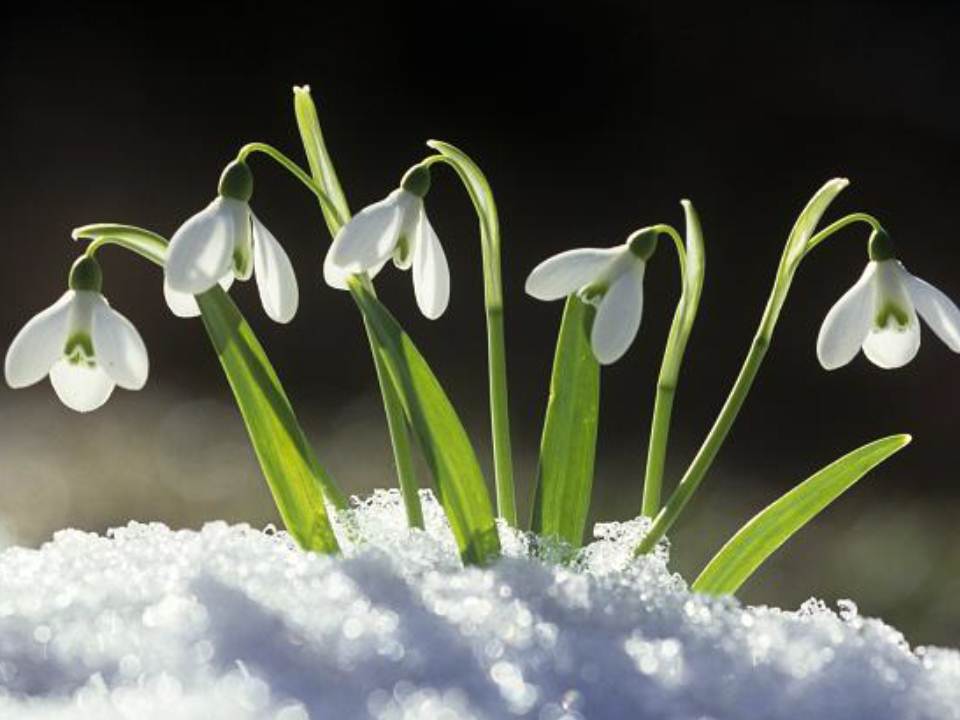 |
Candlemas is not just an old tradition, now forgotten. The festival is still celebrated in many countries. In Spanish-speaking countries it is called 'Candelaria', and in France 'la Chandeleur'. On Epiphany, or 'Three Kings' Day' in Mexico,a figurine representing the baby Jesus is baked into a cake, and the person who finds the baby in their slice is obliged to host the celebration of Candelariaon February 2nd, when a feast of tamalitos and hot chocolate is enjoyed by all. In France and French-speaking Canada, la Chandeleur is better known as 'crepe day'; the round golden crepes enjoyed on that day are reminders of the round golden sun. If you can hold a coin in your writing hand while successfully flipping a crepe with the other hand, it is thought to bring good luck that year. (If you are unsuccessful, it presumably brings immediate good luck to the family dog!)
Candlemas marks the very end of the Christmas season. For some (no doubt including those who commence their secular Christmas season the day after Halloween) Christmas ends abruptly on December 26th. Most folk hold on at least until New Year's Day, and some even celebrate the full 12 days of Christmas until the Feast of Epiphany on January 6th. But for true diehards the Christmas season ends with Candlemas. In medieval times the greens, or at least the nativity scene, were commonly left intact until Candlemas, which gives Christmas the forty days of a major Christian festival along with Advent, Lent and Easter. A rhyme called "Ceremony upon Candlemas Eve" by the British poet Robert Herrick (1591 - 1674) includes the verse:
Down with the rosemary, and so
Down with the bays and misletoe;
Down with the holly, ivy, all,
Wherewith ye dress'd the Christmas Hall.
Thus times and seasons oft do shift; each thing his turn doth hold ;
New thoughts and things now do succeed, as former things grow old.
Kate Rusby, Candlemas Eve, from the album Sweet Bells.
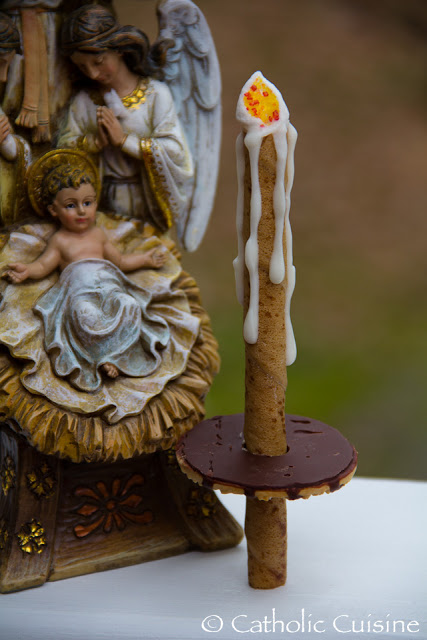 |
Candlemas cookies – American Boxty – Irish Champurrado (hot chocolate) – Mexican Tamales de Chocolate – Mexican Crêpes de la Chandeleur – French |